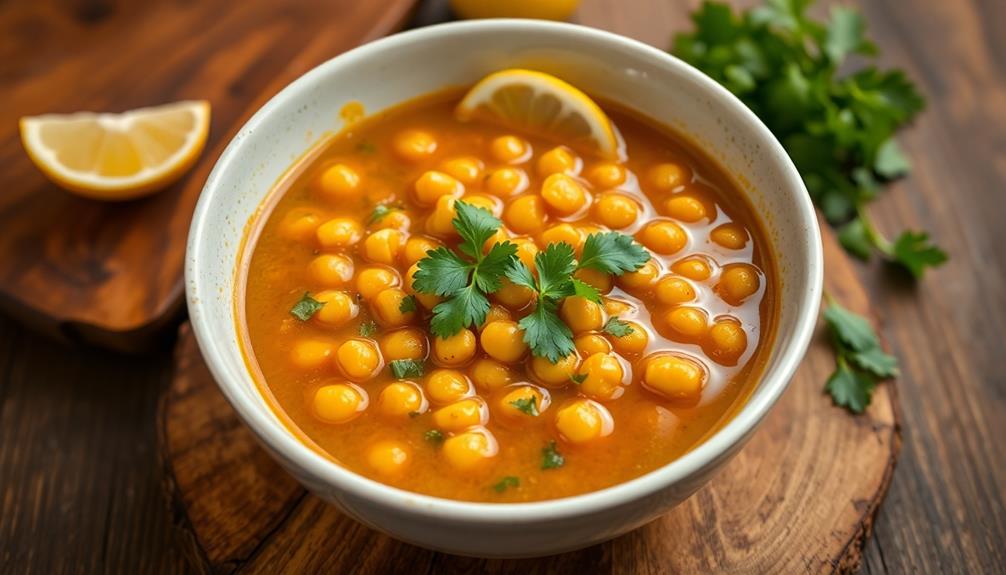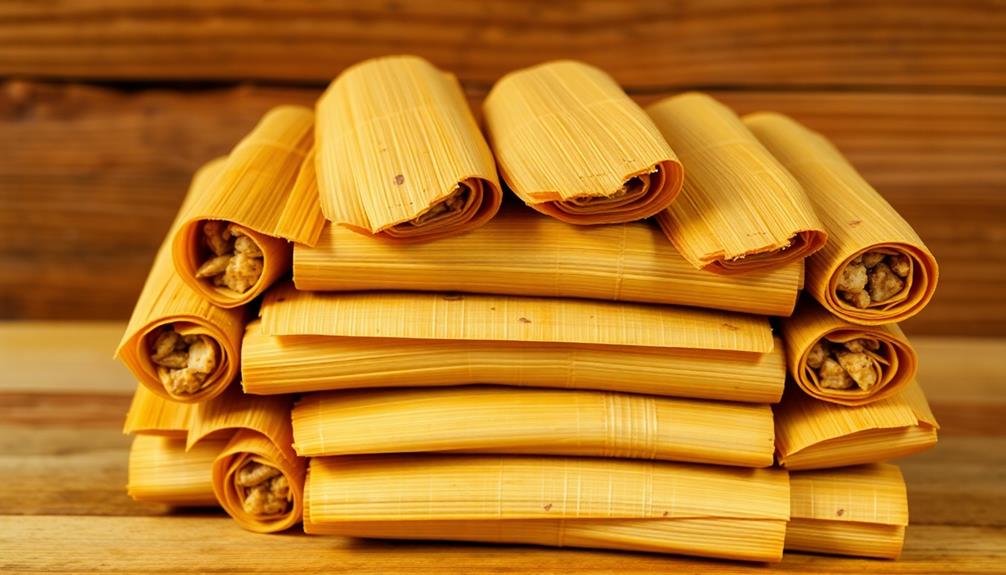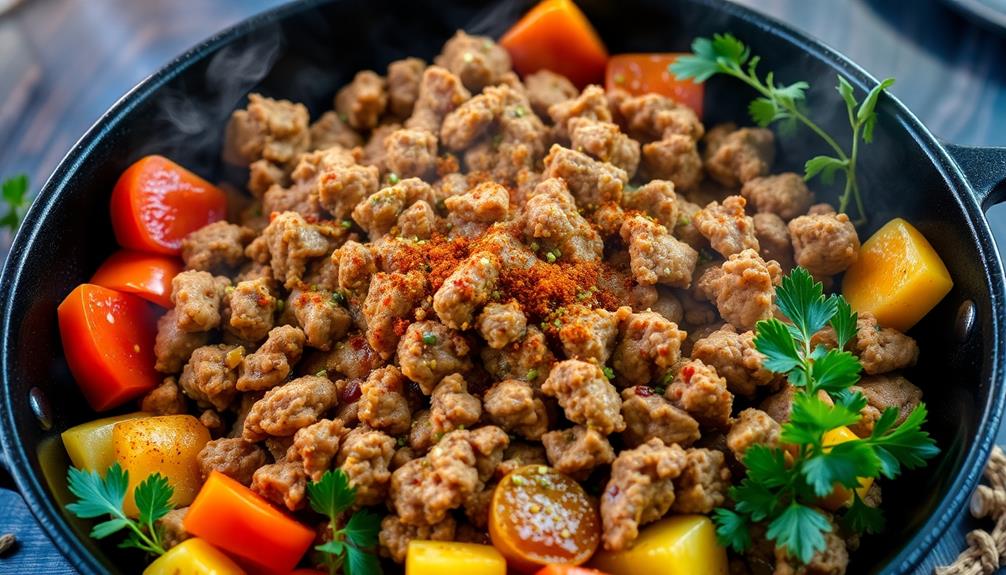Get ready to explore the aromatic and nourishing world of Shiro, a beloved chickpea stew from the rich culinary traditions of Ethiopia. This hearty, plant-based dish combines the nutty, earthy flavors of chickpeas with an array of fragrant spices, vegetables, and herbs, creating a comforting meal that's easy to prepare and packed with nutritious goodness. From the soaking and simmering of the chickpeas to the customizable blend of flavors, Shiro offers a delicious way to savor the global influence of this versatile legume. Let's dive deeper into the history, recipe, and cultural significance of this Ethiopian delicacy. For those looking to create their own authentic Shiro dish at home, look no further than the bozena shiro recipe, which incorporates minced meat into the stew for an added layer of richness and depth. This variation of Shiro showcases the versatility of the dish, allowing for a range of adaptations to suit individual tastes and preferences. Whether enjoyed with injera bread, rice, or on its own, Shiro remains a beloved staple in Ethiopian cuisine, offering a true taste of tradition and community.
Key Takeaways
- Shiro is a traditional Ethiopian chickpea-based stew that is known for its hearty, comforting, and nutritious qualities.
- Chickpeas, also called garbanzo beans, are the main ingredient in Shiro and are a staple in many global cuisines.
- Chickpeas are high in plant-based protein, fiber, and essential vitamins and minerals, making Shiro a healthy and satisfying dish.
- Shiro is typically served with injera, a spongy flatbread, or alongside grains like rice or quinoa for a complete meal.
- Shiro is a culturally significant dish in Ethiopia, often enjoyed during special occasions and gatherings, and represents the flavors of East African cuisine.
History
Chickpeas, also known as garbanzo beans, have a rich history as a dietary staple across the Mediterranean, Middle East, and South Asia.
These versatile legumes have been cultivated since ancient times, with evidence of their use dating back over 7,000 years. From the archaeological sites of the Fertile Crescent to the bustling markets of India, chickpeas have long been a beloved ingredient in a variety of traditional dishes.
In the Middle East, chickpeas are a crucial component of the iconic hummus, while in India, they're the foundation of beloved curries and stews like chana masala.
Across the Mediterranean, chickpeas have been used in everything from soups and salads to roasted snacks. As trade routes expanded, the humble chickpea has traveled the world, becoming a staple in cuisines from North Africa to Latin America.
Today, chickpeas remain an integral part of many culinary traditions, showcasing their enduring popularity and versatility as a nutritious and delicious ingredient.
Recipe
Chickpea Stew is a hearty and flavorful dish that's easy to prepare and perfect for a cozy meal. This plant-based stew is packed with nutritious ingredients and can be customized to suit various dietary preferences.
The combination of chickpeas, aromatic vegetables, and a blend of spices creates a comforting and satisfying dish. Served with a side of crusty bread or over a bed of whole grains, this stew makes for a wholesome and filling meal.
Ingredients:
- 2 cans (15 oz each) chickpeas, drained and rinsed
- 1 onion, diced
- 3 cloves garlic, minced
- 2 carrots, peeled and diced
- 2 celery stalks, diced
- 1 red bell pepper, diced
- 1 can (14.5 oz) diced tomatoes
- 2 cups vegetable broth
- 1 teaspoon ground cumin
- 1 teaspoon paprika
- 1/2 teaspoon dried thyme
- 1/4 teaspoon cayenne pepper (optional, for heat)
- Salt and black pepper to taste
- Chopped fresh parsley for garnish (optional)
In a large pot or Dutch oven, sauté the onion and garlic in a bit of olive oil over medium heat until fragrant and translucent.
Add the carrots, celery, and bell pepper, and continue cooking for 5-7 minutes, or until the vegetables are tender.
Stir in the chickpeas, diced tomatoes, vegetable broth, cumin, paprika, thyme, and cayenne pepper (if using).
Season with salt and black pepper to taste. Bring the mixture to a simmer and let it cook for 20-25 minutes, or until the flavors have melded and the stew has thickened slightly.
Taste and adjust seasonings as needed. Serve the chickpea stew hot, garnished with fresh parsley if desired.
This dish can be enjoyed on its own or paired with crusty bread, rice, or a fresh salad. Leftovers can be stored in the refrigerator for up to 4 days or frozen for longer-term storage.
Cooking Steps
Start by soaking your chickpeas overnight.
Drain and rinse them well the next day.
Next, add your desired spices and let the chickpeas simmer until they're nice and tender, stirring frequently to prevent sticking.
Step 1. Soak Chickpeas Overnight
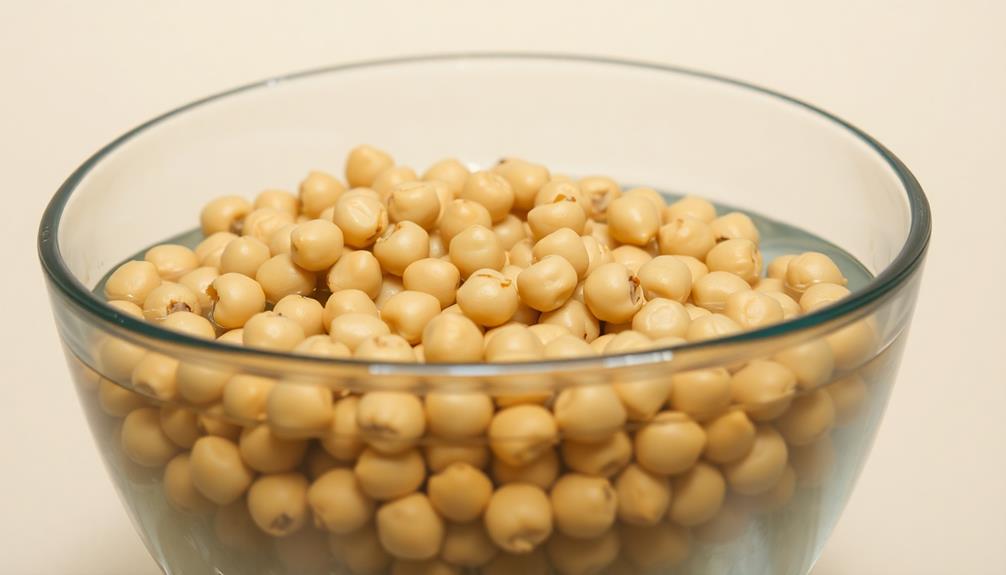
Before you can begin cooking the chickpea stew, you'll need to soak the chickpeas overnight. Start by placing the dried chickpeas in a large bowl and covering them with plenty of water. Let them soak for at least 8 hours, or overnight.
Soaking the chickpeas is an essential step that helps to soften them and reduce their cooking time. It also helps to remove any impurities or debris that may be present in the dried legumes.
Once the chickpeas have soaked, drain and rinse them thoroughly under running water. This will ensure that they're ready to be used in the stew.
Step 2. Drain and Rinse Chickpeas
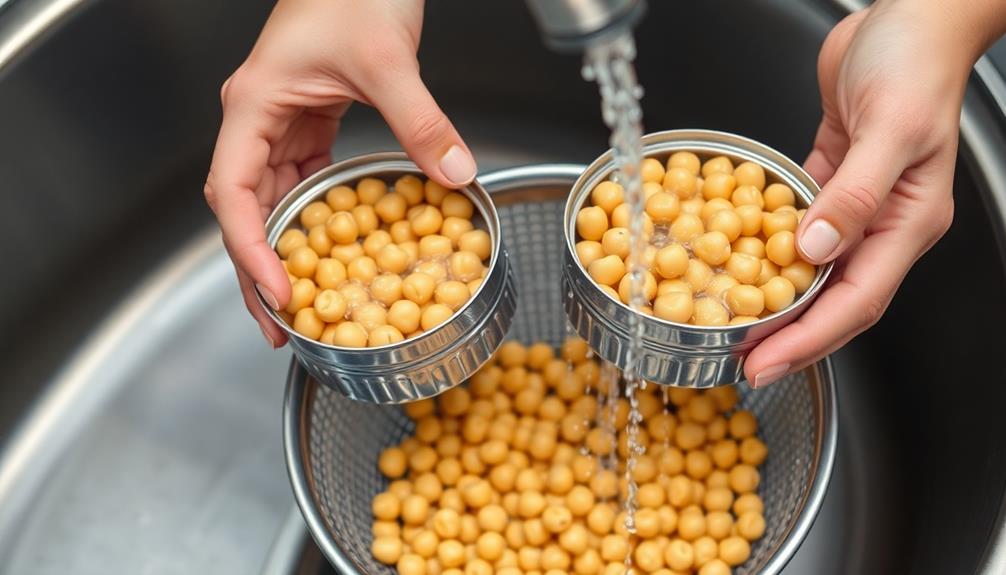
After soaking, drain the chickpeas in a colander and give them a thorough rinse under cool running water. This step helps remove any dirt or debris that may have accumulated during the overnight soak.
It also helps to refresh the chickpeas, preparing them for the next stage of the cooking process.
Once drained and rinsed, the chickpeas are ready to be added to the stew. Make sure to give them a gentle shake to remove any excess water before adding them to the pot. This will prevent the stew from becoming too watery.
Step 3. Add Spices
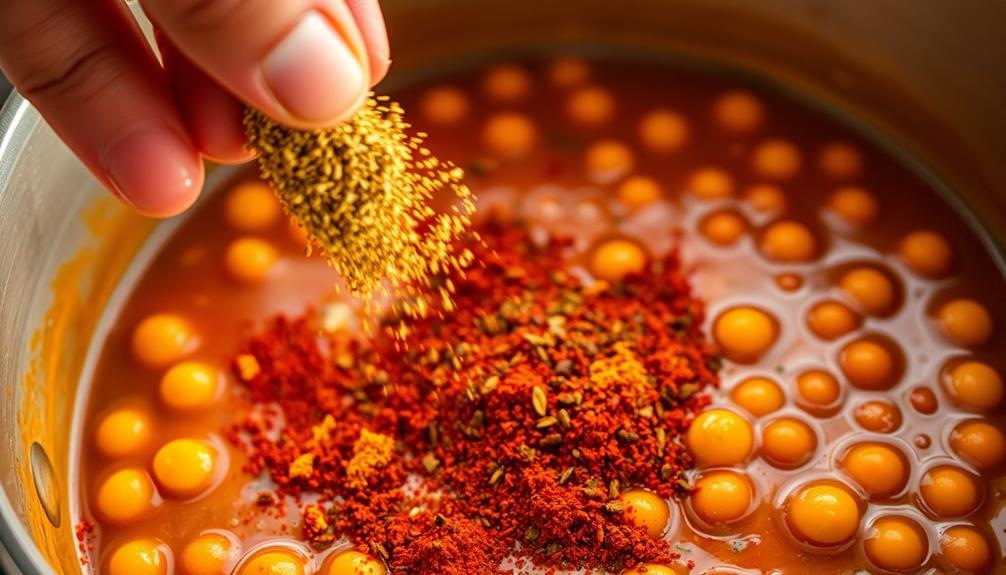
With the chickpeas rinsed and ready, you can now turn your attention to adding the spices. This is where the magic really starts to happen! First, grab your cumin, paprika, and garlic powder.
These three spices will create the warm, aromatic base of your stew, reminiscent of the power of imagination that transforms simple ingredients into a delightful experience. Sprinkle them in and give everything a good stir. Don't be shy with the amounts – you want those flavors to really shine.
Next, add a pinch of cinnamon and a dash of cayenne pepper. The cinnamon will lend a subtle sweetness, while the cayenne brings a gentle kick of heat.
Stir it all together and let the spices mingle for a minute or two. Can you already smell the incredible aroma? It's making your mouth water, isn't it?
Step 4. Simmer Chickpeas Until Tender
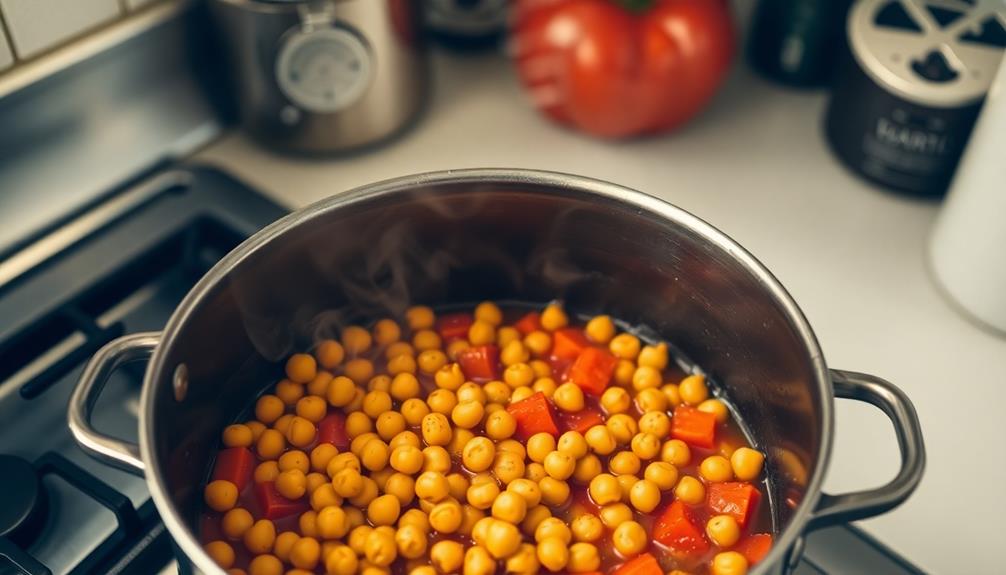
Now that you've added the aromatic spices, it's time to let the chickpeas simmer until they're tender. Bring the stew to a gentle boil, then reduce the heat to medium-low. Cover the pot with a lid, leaving it slightly ajar to allow some steam to escape.
Simmer the chickpeas for 25-30 minutes, stirring occasionally, until they're soft and easily mashed with a fork. The chickpeas should have a creamy, stew-like consistency when they're done. If the stew seems too thick, add a splash of water or broth to thin it out.
As the chickpeas cook, the flavors will meld together, creating a rich, aromatic base for your stew. Keep an eye on the pot, adjusting the heat as needed to maintain a gentle simmer.
Once the chickpeas are tender, you're ready to move on to the next step in your culinary adventure!
Step 5. Stir Frequently During Simmer

Why stir the chickpea stew frequently during the simmering process? Stirring the stew helps to prevent the chickpeas from sticking to the bottom of the pot and burning. It also ensures that the flavors blend evenly, creating a harmonious and delicious dish.
As the stew simmers, the chickpeas will gradually become tender. Stirring the pot every 5-10 minutes helps to distribute the heat evenly, preventing hot spots that could lead to scorching. This also allows the chickpeas to cook through consistently, resulting in a creamy and cohesive texture.
Frequent stirring also helps to incorporate the spices and aromatics, such as onions, garlic, and tomatoes, into the stew. This ensures that each bite is infused with the complex, savory flavors that make this dish so satisfying.
Remember to scrape the bottom of the pot to prevent anything from sticking or burning, and to adjust the heat as needed to maintain a gentle simmer.
Final Thoughts
This chickpea stew recipe offers a satisfying and nourishing meal that's easy to prepare. The final result is a hearty, comforting dish that's perfect for cozy nights or sharing with family and friends.
As you take that first delicious bite, you'll be rewarded with the vibrant flavors of the chickpeas, spices, and vegetables that have melded together beautifully during the simmering process.
Once the stew is ready, you can customize it to your liking. Try topping it with a dollop of yogurt, a sprinkle of fresh herbs, or even a drizzle of olive oil.
The versatility of this dish means you can enjoy it as a main course or as a side to your favorite protein. Serve it alongside warm pita bread or fluffy rice for a complete and satisfying meal.
Savor the comforting aromas and the nourishing goodness of this homemade chickpea stew.
Frequently Asked Questions
Is Shiro Vegan-Friendly?
Yes, shiro can be a vegan-friendly dish. As long as it doesn't contain any animal-derived ingredients like dairy or meat, it's suitable for vegans. Just check the recipe to ensure all the components are plant-based.
What Is the Nutritional Value of Shiro?
Shiro is a nutrient-dense dish that offers a wealth of essential vitamins, minerals, and plant-based protein. It's an excellent source of fiber, folate, and iron, making it a wholesome and filling meal option.
How Long Does Shiro Keep in the Fridge?
Leftover stews typically keep well in the fridge for 3-5 days. To maximize freshness, store it in an airtight container and reheat thoroughly before serving. Enjoy your delicious stew within this timeframe for the best flavor and food safety.
Can Shiro Be Frozen for Later Use?
Yes, you can definitely freeze shiro for later use. Freezing will help extend its shelf life, allowing you to enjoy it well beyond its fresh state. Just be sure to properly store and reheat it when ready to serve.
What Are Some Variations of the Traditional Shiro Recipe?
There are several variations you can try with the traditional recipe. You can add different spices, vegetables, or even meat to create unique flavors. Experiment with your favorite ingredients to find your perfect version of this classic dish.
